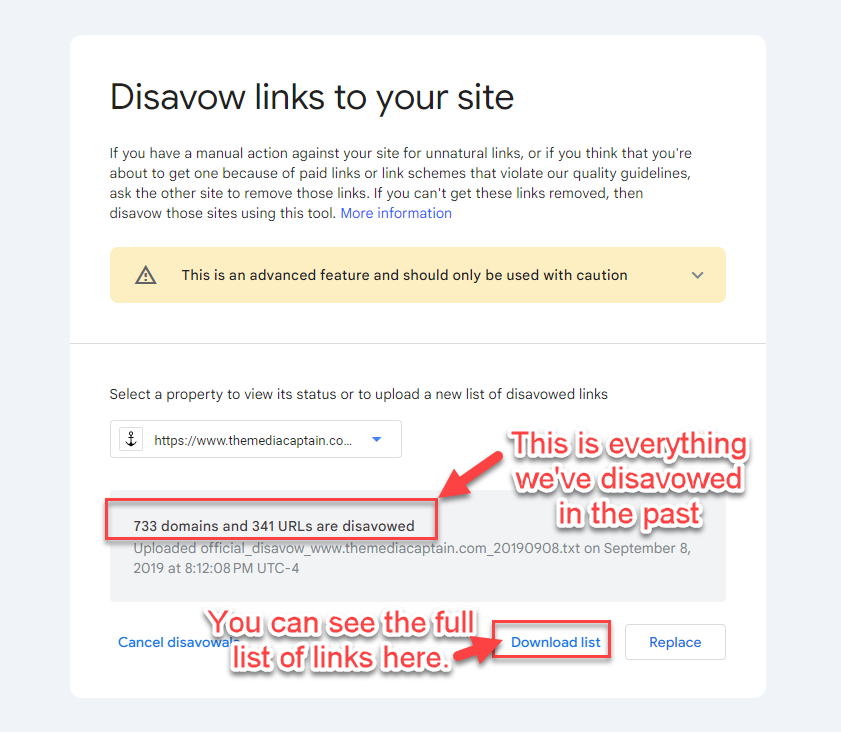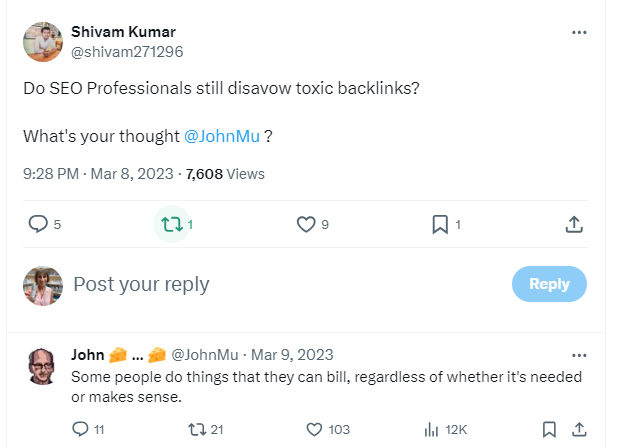Google’s disavow tool allows webmasters to notify Google of poor-quality links pointing to their website that they do not want to be associated with their site. This helps SEOs tell Google which external links to consider when Google evaluates ranking factors [source]. At this point in time, Google is smart enough to simply ignore low-quality backlinks to your website and has gone on record stating you using the Google Disavow Tool is no longer needed. In this blog, we’ll discuss a high-level overview of what the Google disavow tool was all about and why Google made the decision to stop making it a necessity for website owners.
Need help with your SEO strategy? Contact The Media Captain!
What the Google Disavow Tool Looks Like
Below is an example from The Media Captain of what the Google Disavow Tool looks like. As of 4/2024, this tool is still live. You can find the Disavow Tool within Google Search Console. You can see that we’ve disavowed 733 domains and 341 URLs over the years. If you click the link to download the list, you’ll get a TXT file of everything you’ve disavowed.
 History of Google Disavow Tool
History of Google Disavow Tool
In 2012, Google rolled out the Penguin algorithm update, which was one of the most impactful and hard-hitting algorithm updates of all time. This update targeted websites that had low-quality backlinks pointing to their site. Prior to 2012, I would call this the wild wild West of SEO. Since backlinks are such an important ranking factor for Google and there were no strict rules or guidelines in place, website owners were manipulating Google’s search engine. They were acquiring low-quality, irrelevant backlinks, which was, in turn, helping them improve their keyword rankings.
2012 rolled around and Google decided to begin penalizing sites with these low-quality backlinks. This happened during the Penguin algorithm update. At the time, many websites were negatively impacted by this update. If you had bad backlinks pointing to your site, you likely saw your keyword rankings plummet.
Related Blog: Why’d My Keyword Rankings Drop on Google?
Many webmasters weren’t even aware that they had low-quality backlinks pointing to their site. In many cases, SEO agencies that the business employed were building low-quality, spammy links to the site to enhance ranking. Naturally, because of this, Google created the Google disavow tool to upload backlinks telling Google that a business no longer wanted the low-quality links pointing to their site. The tool was rolled out in 2012 and was utilized by webmasters to try and get back in the good graces of Google. The Google disavow tool, in theory, sounded great. You could tell Google to ignore the low-quality links and focus on the high-quality ones.
Related Video: Understanding Google’s Helpful Content Update
How Competitor Spam Started the Downfall of Disavow Tool
Of course, issues arose due to the tool. It began being used as a spam tactic, where competitors would use it against one another. You could essentially outsource low-quality backlink building to India, build 10,000 low-quality backlinks to a competitor’s site, and tank their SEO rankings. While this all sounds sketchy, the tool became extremely problematic once it started being utilized incorrectly.
Related Blog: What Is Domain Authority & Does It Impact SEO?
At this point, Google realized it needed to move away from the Google disavow tool. Starting as early as 2019, Google made subtle hints that it was no longer needed, and they have become more vocal about it over the years.
Google Going on Record Telling Webmasters to Ignore Disavow
Below is a tweet where someone asked, “Do SEO professionals still disavow toxic backlinks? What’s your thought, John Mueller?” John Mueller, the head of the search spam team at Google, stated, “Some people do things that they can bill regardless of whether it’s needed or makes sense.” This implies that there are SEO companies pitching disavowing backlinks to make a quick buck despite not being the right tactic for webmasters.
Related Blog: How to Acquire High Quality Backlinks to Improve SEO
Fascinating Case Study from Glenn Gabe on Undoing Disavow
Glenn Gabe is one of the most well-respected SEO professionals focusing on Google algorithm updates. In 2023, he conducted a case study where he undid a Google disavow tool that had over 15,000 backlinks submitted to it. The result of the study was that the website’s keyword rankings soared upward. They saw huge positive momentum, and if you read the case study, it makes sense. The business was disavowing a lot of natural, quality backlinks unintentionally. Once that was undone, Google was able to detect that, and it improved their keyword ranking. For some websites that currently still have a disavow tool, it may make more sense to cancel the disavows if there’s a chance that you have quality links within there.
In Closing
I would not utilize the Google disavow tool to disavow low-quality backlinks, as Google’s system already takes care of this. Instead, I would use it to possibly undo quality backlinks that are being disavowed within the backlink profile.



